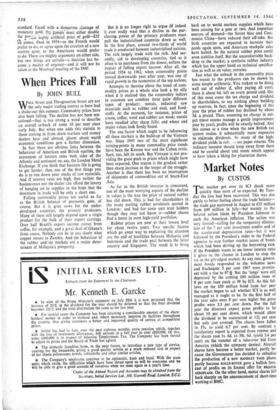When Prices Fall
By JOHN BULL
WALL Street and Throgmorton Street are not the only major trading centres to have had a shake-out this summer. Commodity prices have also been falling. The decline has not been sen- sational—that is too strong a word to describe an overall setback of some 10 per cent since early July. But when one adds this statistic to those coming in from share markets and money dealers here and abroad, gloom about world economic conditions gets a further dimension.
In fact there are obvious links between the behaviour of American and British equities, the movement of interest rates both sides of the Atlantic and sentiment on, say, the London Metal Exchange. If you think that business life is going to get harder, then one of the first things you do is to run down your stocks of raw materials. And if interest rates are high, then neither the businessman nor the dealer can afford the luxury of hanging on to supplies in the hope that the downturn in trade will be only a short one.
Falling commodity prices are useful as far as the British balance of payments goes, of course. But it is grim news for the under- developed countries, the primary producers. Many of them still largely depend upon a single product for the bulk of their export earnings. Over half Brazil's export income comes from coffee, for example, and a great deal of Ghana's from cocoa. Nobody can be in any doubt what copper means to Zambia. And the behaviour of the rubber and tin markets are a major deter- minant of Malaysia's prosperity. But it is no longer right to argue (if indeed it ever really was) that a decline in the pur- chasing power of the primary producers must pull the industrialised countries down as well. In the first place, around two-thirds of world trade is conducted between industrialised nations. The rich largely trade with the rich. And sec- ondly, aid to developing countries, tied as it often is to purchases from the donor, softens the impact of falling export income. After all, the period 1954 to 1962, when commodity prices moved downwards year after year, was one of rapid growth in the economies of the top nations.
Attempts to theorise about the trend of com- modity prices as a whole also look a bit silly when it is realised that the commodity indices in common use combine three quite different types of product: metals, industrial raw materials such as rubber and sisal, and food- stuffs. At the moment, for instance, prices of cocoa, coffee, wool and rubber are weak; metals have steadied after sharp falls; and wheat and maize values look firmly based.
The one factor which ought to be influencing all these markets is the build-up of the Vietnam war. Since 1945 two of the most significant turning-points in many commodity price trends have been the Korean war and the Cuban crisis. Suez, too, left its mark. But Vietnam is not pro- viding the great push to prices which might have been expected. One reason is the gradual rather than sharp increase in the tempo of the struggle. Another is that there has been no interruption of shipments of commodities out of South-East Asia.
As far as the British investor is concerned, one of the most worrying aspects of the decline in values is the way the price of natural rubber has slid down. This is bad for shareholders in the many sterling rubber producers quoted in London: and bad for some unit trust holders though they may not know it—rubber shares find a home in most high-yield portfolios.
Rubber prices are now at their lowest level for about twelve years. Two specific factors which go some way to explaining the situation are the end of hostilities between Malaysia and Indonesia and the trade pact between the latter country and Singapore. The result is to bring
back on to world markets supplies which have been missing for a year or two. And important sources of demand—the Soviet bloc and Com- munist China—have reduced their off-take. But both countries are expected to increase their needs again soon, and American stockpile sales have halted. So the natural rubber price could soon stabilise itself. But the uncomfortable back- drop to the market, a synthetic rubber industry which has the upper hand on technical specifica- tion as well as on value, remains.
Just what the setback in the commodity price has meant to the producers can be shown by some simple arithmetic. You reckon to be doing well out of rubber if, after paying all costs, there is about 6d. left on every pound sold. Out of this must come the tax charge and dividend to shareholders, to say nothing about building up reserves. In fact, since the beginning of this year the price of rubber has declined by about 3d. a pound. Thus, assuming no change in out- put (most estates manage a gentle improvement year by year), profits will be exactly halved. And this comes at a time when the new British tax system makes it substantially more expensive to maintain dividends. So many of the high- dividend yields in rub... s are paper returns. The ordinary investor should keep away from them and be careful about unit trusts which appear to have taken a liking for plantation shares.


































 Previous page
Previous page